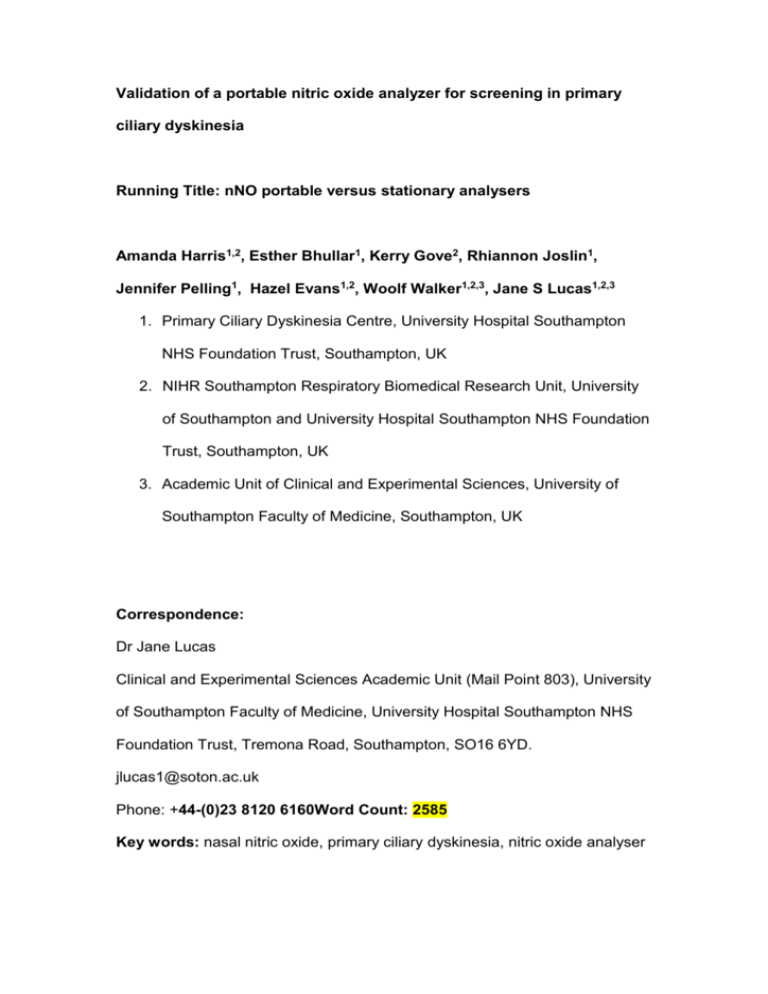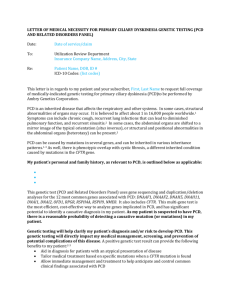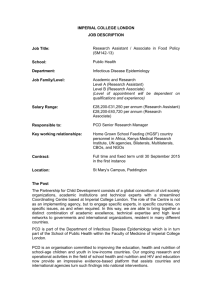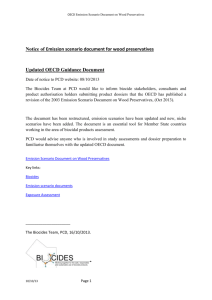Measurement of nasal nitric oxide using a portable
advertisement

Validation of a portable nitric oxide analyzer for screening in primary ciliary dyskinesia Running Title: nNO portable versus stationary analysers Amanda Harris1,2, Esther Bhullar1, Kerry Gove2, Rhiannon Joslin1, Jennifer Pelling1, Hazel Evans1,2, Woolf Walker1,2,3, Jane S Lucas1,2,3 1. Primary Ciliary Dyskinesia Centre, University Hospital Southampton NHS Foundation Trust, Southampton, UK 2. NIHR Southampton Respiratory Biomedical Research Unit, University of Southampton and University Hospital Southampton NHS Foundation Trust, Southampton, UK 3. Academic Unit of Clinical and Experimental Sciences, University of Southampton Faculty of Medicine, Southampton, UK Correspondence: Dr Jane Lucas Clinical and Experimental Sciences Academic Unit (Mail Point 803), University of Southampton Faculty of Medicine, University Hospital Southampton NHS Foundation Trust, Tremona Road, Southampton, SO16 6YD. jlucas1@soton.ac.uk Phone: +44-(0)23 8120 6160Word Count: 2585 Key words: nasal nitric oxide, primary ciliary dyskinesia, nitric oxide analyser Abstract Background: Nasal nitric oxide (nNO) levels are very low in primary ciliary dyskinesia (PCD), making measurement suitable as a screening test. Methods: We assessed the reliability and usability of a hand-held analyser in comparison to a stationary nNO analyser in 50 participants (15 healthy, 13 PCD, 22 other respiratory diseases; age 6-79 years). Nasal NO was measured using a stationary NO analyser during a breath-holding manoeuvre, and using a hand-held analyser during tidal breathing, sampling at 2ml/sec or 5ml/sec. The three methods were compared for their specificity and sensitivity as a screen for PCD, their success rate in different age groups, within subject repeatability and acceptability. Correlation between methods was assessed. Results: Valid nNO measurements were obtained in 94% of participants using the stationary analyser, 96% using the hand-held analyser at 5ml/sec and 76% at 2ml/sec. The hand-held device at 5ml/sec had excellent sensitivity and specificity as a screening test for PCD during tidal breathing (cut-off of 30nL/min,100% sensitivity, >95% specificity). The cut-off using the stationary analyser during breath-hold was 38nL/min (100% sensitivity, 95% specificity). The stationary and hand-held analyser (5ml/sec) showed reasonable withinsubject repeatability(% coefficient of variation=15). Conclusion: The hand-held nNO analyser provides a promising screening tool for PCD. Background Primary ciliary dyskinesia (PCD) is an autosomal recessive condition in which abnormal ciliary function leads to impaired mucociliary clearance and consequent recurrent upper and lower respiratory tract infection[1]. Approximately half the patients have situs inversus and male infertility is common[1]. Early diagnosis is important to ensure appropriate management and counselling; several[2;3] studies suggest that early diagnosis and treatment improves long-term prognosis. To comply with European consensus guidelines diagnosis of PCD includes investigations requiring access to highly specialised equipment and diagnostic scientists[4-6]. Such facilities are not widely available, contributing to the inequality of diagnosed cases throughout Europe[7]. Nasal NO (nNO) is characteristically low in PCD[8;9], so much so that nNO is recommended as a pre-diagnostic screening test for the condition[4;5;10-12]. Until recently, the only commercially available analyzers for measuring nNO were non-portable desktop analyzers which are extremely expensive. A reasonably priced, practical method of measuring nNO might improve the disparity in diagnosis and reduce diagnostic costs by reliably identifying patients for referral to specialist centres. A number of handheld devices have proved beneficial for measuring fractional exhaled nitric oxide in patients with asthma[13-16] in clinical and research settings. Commercially available hand-held analyzers have recently been adapted to measure nNO in breath-hold and tidal breathing modes[17;18]. A study of PCD and CF patients reported a hand-held device to be as effective as the stationary analyser for assessing nNO during silent and humming exhalation[19]. Furthermore, a recent study has showed that tidal breathing nNO measured by a hand-held NO device discriminates between PCD, cystic fibrosis (CF) and healthy controls (HC)[20].The aim of this single center crosssectional study was to evaluate the ability of a commercially available analyzer (NIOX MINO®) to discriminate between PCD, other respiratory diseases and healthy controls in comparison to a ‘gold standard’ chemiluminescence analyser (NIOX® Flex). Methods This study was approved by Southampton and South West Hampshire Research Ethics Committee A (06/Q1702/109 and 08/H0502/126). All subjects gave written informed consent. Participants Fifty people consented to participate in this study, including 15 healthy volunteers, 13 with PCD and 22 with other respiratory disorders. Children and adults with PCD, cystic fibrosis (CF) (n=6), and non-CF non-PCD chronic suppurative lung disease (CSLD) (n=7) were recruited from specialist PCD and respiratory clinics. Those with asthma +/- hay fever (n=9) were recruited from amongst staff/students and from respiratory clinics. Healthy participants completed a short questionnaire to exclude disease that might affect nitric oxide levels. PCD was diagnosed at Southampton’s national PCD centre by analysing respiratory epithelia ciliary beat frequency and pattern using high-speed video microscopy in patients with a suggestive history[4;6;21]. Diagnosis was supported by assessment of ciliary ultrastructure by transmission electron microscopy (TEM). In some cases diagnosis was further clarified by analysis of re-differentiated cilia following culture of the airway epithelial cells at an air liquid interface. CF diagnosis was based on compatible history, an abnormal sweat test and/or CF genotyping. CSLD participants were recruited from patients with a chronic history of purulent sputum referred to the PCD diagnostic service who had the diagnosis of PCD and CF excluded. They had not necessarily had a HRCT; bronchiectasis had therefore not been radiologically excluded nor confirmed. Asthma diagnosis was self-reported amongst staff and students. Measurement of airway nitric oxide Two different devices were used: NIOX MINO® and NIOX® Flex analysers. Measurement of nNO levels using NIOX® Flex (Aerocrine, Sweden) uses chemiluminescence with sampling at 5ml/s[22], whilst the NIOX MINO® uses an electrochemical sensor and provides a result after sampling for 90 seconds at 2ml/s or for 45 seconds at 5ml/s. The analyser only provides a result if uninterrupted sampling has been maintained throughout this sampling time. NIOX MINO® can also sample during tidal breathing. The NIOX® Flex analyser was maintained, calibrated and tested according to manufacturer’s guidelines. Measurements were made by health care professionals who had been trained following a standard operating procedure derived from the manufacturer’s guidelines. In brief, ambient NO was noted before testing patients. All patients were symptomatically free of viral infection or respiratory exacerbation. Participants were requested to blow their nose before testing. A nasal probe sampled gas aspirated from the nostril at a rate of 5ml/sec during a breath-holding manoeuvre. Patients held their breath for approximately 20 seconds until the real-time analyser recorded a plateau in nitric oxide concentrated from the aspirated gas. The measurement was recorded from a steady nNO concentration plateau of at least 4 seconds. Three measurements within 10% were obtained for each participant using the same nostril and the maximum nNO reading was recorded. nNO concentration in parts per billion (ppb) were converted to NO production (nL/min) using the equation NO production (nL/min) = nNO concentration (ppb) x sampling flow rate (litres/min). The NIOX MINO® was used in nasal mode. A nasal probe sampled gas aspirated from the nostril at 5mls/sec and was then repeated at 2ml/sec. Following ATS[22] and manufacturer’s guidelines we initially attempted these measurements during breath-holding manoeuvres To obtain a test result the participant needed to achieve uninterrupted sampling for 45 seconds whilst sampling at 5 ml/sec or 90 seconds at 2ml/sec. Breath holding for this duration was not achievable even by healthy adult volunteers and it was decided to abandon this manoeuvre. Instead we followed the alternative method suggested by the manufacturers of sampling nasal gas at 2 ml/sec and 5 ml/sec during mouth breathing. Three recordings at each rate were attempted, and the highest was taken. Usability and reliability of analysers The multidisciplinary clinical PCD team who undertook these measurements (paediatrician, PCD nurse specialist, PCD respiratory physiotherapist and respiratory technicians) discussed the pros and cons of the analysers. Their consensus opinions were recorded.. The success rate for obtaining a measurement with each analyser was recorded. Statistical analyses The highest of three measurements for each method was recorded. Nasal NO values were log10 transformed where appropriate because data was not normally distributed. Comparisons between disease groups were made using unpaired t-tests. Comparisons between analyzers were made using paired t- tests. Receiver Operating Characteristic (ROC) curves were used to determine cut of values, sensitivity and specificity. Pearson correlation coefficients were calculated to investigate correlation between nNO values obtained with the NIOX® Flex and NIOX MINO®.Brand Altman plots were constructed with the difference of measurements from the two analyzers plotted against the mean of the two methods. The reproducibility of analyzers was reported as the intra-subject % Coefficient of Variability (%CV); this was calculated by calculating the standard deviation for the three measurements taken using each protocol, and dividing that by the triplicate mean, and multiplying by 100. Data were analyzed using statistical analysis software SPSS version 19.0.0 (IBM, USA). Results Valid readings were obtained in 47 participants using the NIOX® Flex breathhold protocol. Three participants (aged 5, 8 and 8 years) were unable to breath-hold for 20 seconds to obtain a technically acceptable measurement. Using the NIOX MINO® healthy adults were unable to manage the breath-hold protocol of 45 seconds for 5 ml/sec or 90 seconds for 2 ml/sec and we abandoned these protocols with no resulting data. However measurement during tidal mouth breathing using the NIOX MINO® successfully provided data for 48 participants at a sampling rate of 5ml/sec and 38 participants at 2 ml/sec. The mean (range) ages of participants in each group were: healthy controls 31 years (8-65), PCD 23 years (5-71), CF 15 years (6-29), asthma 35 years (12-59) and CSLD 36 years (8-79). Nasal NO as a screening tool for PCD Using the NIOX® Flex, patients with PCD had significantly lower levels of nNO than healthy controls (p<0.001), CF (p=0.003), asthma (p<0.001) and CSLD (p=0.005). Statistically lower nNO values were similarly obtained in patients with PCD when using the NIOX MINO® at 5 ml/sec (HC p<0.001; CF p=0.028; asthma p<0.001; CSLD p=0.002). Using the NIOX MINO® sampling at 2 ml/ sec, patients with PCD had significantly lower nNO measurements than HC (p<0.001), CF (p=0.001) and asthma (p<0.001). However, two participants with CSLD had very low levels (<6nL/min) and there was no statistical difference in nNO values between this group and those with PCD (p=0.11). One participant with CF and normal ciliary function and ciliary ultrastructure, had very low levels of nNO (<30nL/min) measured using the NIOX® Flex and NIOX MINO®. Receiver operating characteristic (ROC) curves were generated for the NIOX® Flex and NIOX MINO® at 2 ml/ sec and 5ml/sec in cases with PCD versus participants without PCD (curves not shown) and cut-off values were determined for optimal sensitivity and specificity (Table 1). Using NIOX® Flex, a nNO cut off levels of 38nL/min had 100% sensitivity and 95% specificity for distinguishing PCD patients from non-PCD patients. A cut off value of 30nL/min when using the NIOX MINO® sampling at 5 ml/sec, provided 100% sensitivity and 95% specificity; using the same analyser, sampling at 2 ml/sec, a cut of value of 43nL/min provided 100% sensitivity and 93% specificity for differentiating PCD patients from the other groups. Comparison of nNO values between analysers Comparing analysers, within patients, the NIOX MINO® sampling at 5ml/sec or 2ml/sec consistently measured lower (p<0.001, p<0.001) than the NIOX® Flex (Figure 1). Pearson correlation analysis showed excellent linear association between nNO readings obtained by NIOX® Flex and NIOX MINO® at 5 ml/sec or 2 ml/sec (r=0.93 p<0.001 and r=0.93 p<0.001 respectively). The relationship between the nNO measured by NIOX® Flex and NIOX MINO® at 5 ml/sec were further investigated by Bland-Altman plot (Figure 2). The BlandAltman plots show a high degree of difference between readings from the two analysers, particularly in participants with very high levels of nNO. However the patients with PCD all had low nNO levels, and this group all demonstrated low variability of readings between analysers. Reproducibility within-analyser The intra-subject %CV showed good repeatability between three measurements taken during the same visit using NIOX® Flex (%CV=9) and reasonable repeatability using the NIOX MINO® at 5 ml/sec (%CV=15) and NIOX MINO® at 2 ml/sec (%CV=14). Usability of the analysers Prior to the study the nurse specialist and physiotherapist were highly experienced obtaining nNO readings from adults and children using the NIOX® Flex breath-hold protocol. They were unable to obtain readings with the NIOX MINO® using the breath-hold technique because even healthy adults were unable to breath-hold for the requisite time. Their assessment (Table 2) was that younger children were sometimes able to achieve nNO readings using the NIOX MINO® by using the mouth breathing technique with sampling at 5ml/sec, even when acceptable reading were not obtained using the NIOX® Flex. However, the NIOX MINO® sampling at 2ml/sec was a very lengthy procedure and fewer participants achieved it. The portability of the NIOX MINO® was considered a benefit by health care professionals involved in the study, although the need to be placed on a firm, flat surface and the short sampling tube were poorer ergonomic features. Discussion and conclusions This study confirmed that the hand-held NIOX MINO® provides a reliable screening tool for PCD compared to the NIOX® Flex in this study population. We were unable to obtain readings using the NIOX MINO® during breathholding but found NIOX MINO® nNO readings taken during mouth breathing correlated well with measurements from the NIOX® Flex during breath-holding manoeuvres. This was particularly true for patients with PCD. Within our study population, we were more successful ( 96% versus 76% success) and quicker (15-30 minutes versus 20-40minutes) measuring nNO using the NIOX MINO® at 5ml/sec than at 2ml/sec; we found no advantage for measuring at 2ml/sec and would use 5ml/sec in the future.. We noted that all three methods gave reproducible results. Although the methods were well correlated, there were differences in the mean nNO levels between analysers. nNO production recorded by the NIOX MINO® was lower than that recorded by the NIOX® Flex. This is likely to reflect contamination of the nasal sample by lower airway gas during mouth breathing and short mucosal contact time. Reference values will therefore be required for each method and analyser. In our population, a cut-off value of 38nL/min provided 100% sensitivity and 95% specificity using the NIOX® Flex during breath-hold. A cut-off of 30 nL/min using the NIOX MINO® (tidal breathing with sampling at 5ml/sec) provided 100% sensitivity and 95% specificity. These cut off values are somewhat lower that those reported in a large study investigating the use of nNO as a screening test for PCD[11]. Leigh et al determined a cut off value of 77nL/min was 98% sensitive and >99.9% specific when screening patients at their PCD centre. The authors then used the same protocol to measure nNO in 155 patients referred for PCD diagnostic testing at six other hospitals. They found that this level correctly identified 70 of the 71 participants who were confirmed to have PCD. A study using the NIOX® Flex and NIOX MINO® to measure nNO during silent and humming exhalations[4;19] calculated lower cut-off values than in our study. This is likely to reflect greater contamination by lower airway gases during these exhalation manoeuvres. Importantly, the key findings of both manuscripts[11;19] were in line with our paper, i.e. PCD patients have lower nNO than healthy controls or CF patients, and the handheld device is effective for screening to differentiate PCD from other groups. Whilst there is now substantial data to demonstrate that nNO measurement is helpful in guiding the diagnostic pathway, we need to recognize limitations of this measurement[12]. Standardized methods to measure nNO are not appropriate for younger children, precisely the age group that need targeting for diagnostic measurement. Sampling during tidal breathing provides a potential method in this group, but data is limited[23]. Low nNO has previously been described in patients with CF and other respiratory conditions. One of our patients with CF and negative PCD diagnostics had very low levels of nNO (NIOX® Flex 17 nL/min, NIOX MINO® 5ml/sec 5 nL/min). Two patients with CSLD also had low levels of nNO. Both had PCD excluded using protocols that follow ERS guidelines[4]. They had normal ciliary beat frequency and pattern before and following culture at air liquid interface. They also had normal ultrastructure by TEM. These data demonstrate that although nNO is useful as a screening test, it is not a substitute for formal assessment of ciliary function and assessment of ciliary ultrastructure. It is noteworthy that although all PCD patients in this study had very low levels of nNO, occasionally PCD patients with normal levels have been described[10;23;24]. This highlight that patients with a history strongly suggestive of PCD should not be excluded from further diagnostic evaluation on the basis of nNO. An important observation by the authors has arisen from referrals to our diagnostic service where nNO has been measured by the referring team using NIOX MINO®. A number of patients have been noted to have extremely low levels of nNO at the referring hospital, but normal/ high levels when measured using the NIOX MINO® or NIOX® Flex at our centre. We suspect this might reflect leaks at the nares or excessive lower airway contamination, and highlights the need for training and standardised protocols if the NIOX MINO ® is to be used as a screening test at satellite hospitals. In summary, nNO measurements using the NIOX MINO® successfully discriminates PCD patients from healthy individuals and those with other lung conditions. Nasal NO values were reproducible and correlated well with the NIOX® Flex. The NIOX MINO® is easily portable and relatively cost-effective as compared to the desktop NIOX® Flex. Health care professionals and patients found it acceptable. Hand-held devices therefore provide a promising screening tool for PCD although further studies will be required to establish reference data. Competing interest statement The authors declare that they have no competing interests. Author contributions AH had the idea for the research and designed the study; EB, KG, RJ & JP undertook clinical testing and data recording; AH, HE and JSL undertook data analysis and interpretation; HE, WW & JSL recruited patients and are clinical leads for the PCD diagnostic service; all authors contributed to and approved the manuscript; JSL takes responsibility for the integrity of the study data and analysis. Acknowledgements The Primary Ciliary Dyskinesia Centre Southampton is funded by the National Specialised Commissioning Team, NHS England. This study was supported by the Southampton NIHR Wellcome Trust Clinical Research Facility and NIHR Southampton Respiratory Biomedical Research Unit. Aerocrine loaned the NIOX MINO® to evaluate its use in our clinic population. References 1. Lucas JS, Walker WT, Kuehni CE, Lazor R. Primary Ciliary Dyskinesia. In: Courdier J-F, ed. Orphan Lung Diseases. European Respiratory Society, 2011: 201-17. 2. Ellerman A, Bisgaard H. Longitudinal study of lung function in a cohort of primary ciliary dyskinesia. Eur Respir J 1997; 10:2376-9. 3. Hellinckx J, Demedts M, De BK. Primary ciliary dyskinesia: evolution of pulmonary function. Eur J Pediatr 1998; 157:422-6. 4. Barbato A, Frischer T, Kuehni CE, Snijders D, Azevedo I, Baktai G, Bartoloni L, Eber E, Escribano A, Haarman E, Hesselmar B, Hogg C, Jorissen M, Lucas J, Nielsen KG, O'Callaghan C, Omran H, Pohunek P, Strippoli MP, Bush A. Primary ciliary dyskinesia: a consensus statement on diagnostic and treatment approaches in children. Eur Respir J 2009; 34:1264-76. 5. Bush A, Chodhari R, Collins N, Copeland F, Hall P, Harcourt J, Hariri M, Hogg C, Lucas J, Mitchison HM, O'Callaghan C, Phillips G. Primary ciliary dyskinesia: current state of the art. Arch Dis Child 2007; 92:1136-40. 6. O'Callaghan C, Chilvers M, Hogg C, Bush A, Lucas J. Diagnosing primary ciliary dyskinesia. Thorax 2007; 62:656-7. 7. Kuehni CE, Frischer T, Strippoli MP, Maurer E, Bush A, Nielsen KG, Escribano A, Lucas JS, Yiallouros P, Omran H, Eber E, O'Callaghan C, Snijders D, Barbato A. Factors influencing age at diagnosis of primary ciliary dyskinesia in European children. Eur Respir J 2010; 36:124858. 8. Karadag B, James AJ, Gultekin E, Wilson NM, Bush A. Nasal and lower airway level of nitric oxide in children with primary ciliary dyskinesia. Eur Respir J 1999; 13:1402-5. 9. Wodehouse T, Kharitonov SA, Mackay IS, Barnes PJ, Wilson R, Cole PJ. Nasal nitric oxide measurements for the screening of primary ciliary dyskinesia. Eur Respir J 2003; 21:43-7. 10. Walker WT, Jackson CL, Lackie PM, Hogg C, Lucas JS. Nitric oxide in primary ciliary dyskinesia. Eur Respir J 2012; 40:1024-32. 11. Leigh MW, Hazucha MJ, Chawla KK, Baker BR, Shapiro AJ, Brown DE, Lavange LM, Horton BJ, Qaqish B, Carson JL, Davis SD, Dell SD, Ferkol TW, Atkinson JJ, Olivier KN, Sagel SD, Rosenfeld M, Milla C, Lee HS, Krischer J, Zariwala MA, Knowles MR. Standardizing Nasal Nitric Oxide Measurement as a Test for Primary Ciliary Dyskinesia. Ann Am Thorac Soc 2013 In press December 2013 12. Lucas JS, Walker WT. Nitric Oxide Is an Important Test in the Diagnostic Pathway for Primary Ciliary. Ann.Am.Thorac.Soc. in press. December 2013. 13. Boot JD, de RL, de Kam ML, Calderon C, Mascelli MA, Diamant Z. Comparison of exhaled nitric oxide measurements between NIOX MINO electrochemical and Ecomedics chemiluminescence analyzer. Respir Med 2008; 102:1667-71. 14. Kim SH, Moon JY, Kwak HJ, Kim SI, Park DW, Kim JW, Kim TH, Sohn JW, Shin DH, Park SS, Yoon HJ. Comparison of two exhaled nitric oxide analyzers: the NIOX MINO hand-held electrochemical analyzer and the NOA280i stationary chemiluminescence analyzer. Respirology 2012; 17:830-4. 15. Schiller B, Hammer J, Barben J, Trachsel D. Comparability of a handheld nitric oxide analyser with online and offline chemiluminescencebased nitric oxide measurement. Pediatr Allergy Immunol 2009; 20:679-85. 16. Selby A, Clayton B, Grundy J, Pike K, Drew K, Raza A, Kurukulaaratchy R, Arshad SH, Roberts G. Are exhaled nitric oxide measurements using the portable NIOX MINO repeatable? Respir Res 2010; 11:43. 17. Maniscalco M, de LG, Weitzberg E, Lundberg JO, Sofia M. Validation study of nasal nitric oxide measurements using a hand-held electrochemical analyser. Eur J Clin Invest 2008; 38:197-200. 18. Weschta M, Deutschle T, Riechelmann H. Nasal fractional exhaled nitric oxide analysis with a novel hand-held device. Rhinology 2008; 46:23-7. 19. Montella S, Alving K, Maniscalco M, Sofia M, De SS, Raia V, Santamaria F. Measurement of nasal nitric oxide by hand-held and stationary devices. Eur J Clin Invest 2011; 41:1063-70. 20. Marthin JK, Nielsen KG. Hand-held tidal breathing nasal nitric oxide measurement--a promising targeted case-finding tool for the diagnosis of primary ciliary dyskinesia. PLoS One 2013; 8:e57262. 21. Bush A, Cole P, Hariri M, Mackay I, Phillips G, O'Callaghan C, Wilson R, Warner JO. Primary ciliary dyskinesia: diagnosis and standards of care. Eur Respir J 1998; 12:982-8. 22. ATS/ERS recommendations for standardized procedures for the online and offline measurement of exhaled lower respiratory nitric oxide and nasal nitric oxide, 2005. Am J Respir Crit Care Med 2005; 171:912-30. 23. Marthin JK, Nielsen KG. Choice of nasal nitric oxide technique as firstline test for primary ciliary dyskinesia. Eur Respir J 2011; 37:559-65. 24. Pifferi M, Bush A, Caramella D, Di CM, Zangani M, Chinellato I, Macchia P, Boner AL. Agenesis of paranasal sinuses and nasal nitric oxide in primary ciliary dyskinesia. Eur Respir J 2011; 37:566-71. Figure and table legends Figure 1: Box plots demonstrating nasal NO production (nL/min) in the different disease groups (line: median, box: quartiles, whiskers: minimum and maximum. Measurements were taken using (a) NIOX® Flex using a breathhold manoeuver and NIOX MINO® during mouth breathing with nasal sampling at (b) 2 ml/ sec and (c) 5ml/sec. Figure 2: Bland Altman plots comparing the NIOX® Flex with NIOX MINO® at 5ml/sec. Each point represents the difference between the nNO readings (ppb) obtained from a patient using the two analysers versus the mean of the two measurements. The reference lines represent the mean (and 1.96*SD) inter-analyser differences. Table 1 Nasal nitric oxide cut-off values to discriminate between PCD and non-PCD groups using different analysers. Table 2 Comparison of analysers and methods reflecting the opinions of the multidisciplinary specialist PCD team having conducted the research. Table 1 nNO cut-off value (nL/min) NIOX® Flex Breath-hold Niox Mino5ml/sec Niox Mino2ml/sec Tidal breathing Tidal breathing 38 30 43 100 100 100 95 95 93 Sensitivity % Specificity % Table 2 NIOX® Flex 20 seconds breath-hold protocol NIOX MINO® 2ml/sec 5ml/sec Breath hold (45 sec/ 90 sec) Poor Poor Poor Fair Poor Good Good Good Fair Fair Good Good Healthy adults were unable to manage the prolonged breath hold required for this analyser. Time to complete 3 readings 5-10 min 20-40 min 15-30 min Incentive software No No Practical issues Needs stable environment and dedicated work space. Poor portability Breath-holding technique difficult for young children and advanced lung disease Needs to be used on a flat surface Cost of machine Very Expensive. Approx £30,000 Expensive. Approx £2,100 Need for calibration gases Yes. Approx £1,500 per annum No Need for maintenance service Yes. Approx £3,800 per annum No Consumables Nasal sampling Nasal sampling olives: £40 per Ease of use by: Younger children Children >8 years Teenagers Adults Excellent portability Most people could manage the technique but it resulted in a dry mouth. Short sampling catheter olives: £40 per 100 100 patients Longevity Good Sensor needs replacing after 100 or 300 readings (using our protocol 30 or 100 patients). Many readings failed but were still ‘counted’. Sensor expires after 1 year Approx. £1,215 for sensor 300. Range of nNO (ppb) 25-2000ppb 5-1700ppb Effected by other electronic devices in room e.g. mobile phones No Yes









